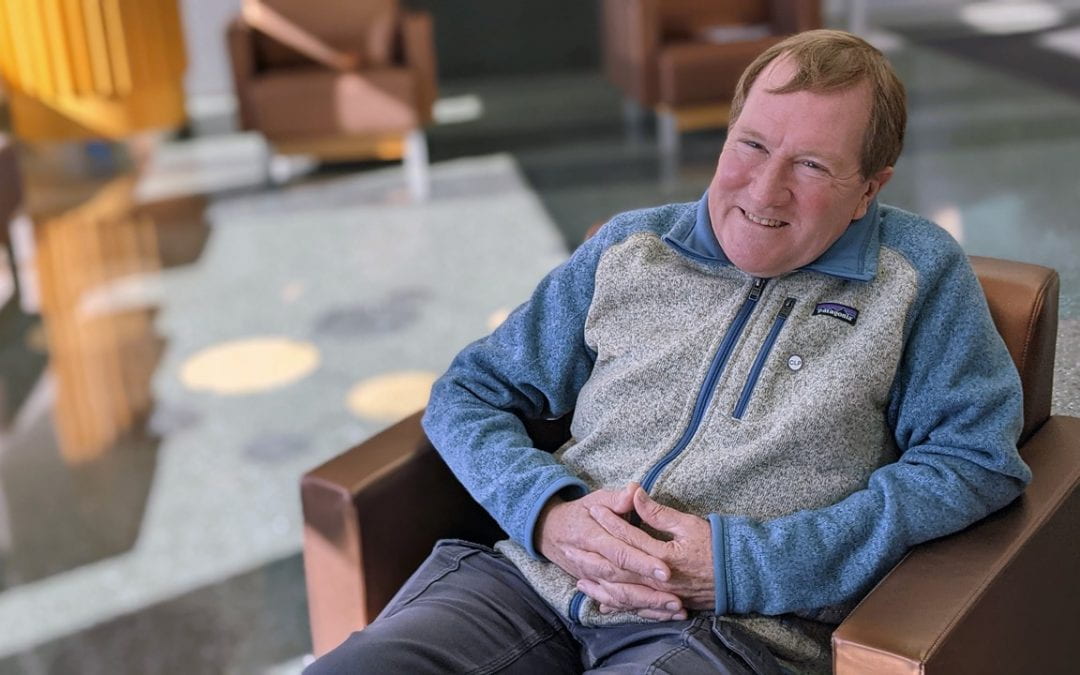“I’m the luckiest human you’ve ever met,” says Stuart Cornew, founder of Chemistry of Life Processes Institute’s (CLP) Executive Advisory Board (EAB) and one of the Institute’s earliest champions. “I was diagnosed with a dread disease [multiple myeloma, a type of blood cancer]. They told me I had 29 months to live. That was 19 years ago. I’m still married to the same woman and have two terrific sons and I’ve survived, not one, but two, airplane crashes.”
A successful businessman and entrepreneur, Cornew, who is Managing Director of AnswerMine, was an early supporter of CLP. After a series of conversations in 2001 with CLP’s founding director Thomas O’Halloran, a neighbor and fellow Boy Scout parent, Cornew immediately warmed to the chemist’s bold vision to create an academic destination for biomedical discovery that eliminated silos between disciplines. The idea was to provide a central space for biologists, chemists, engineers, and clinicians to collaborate on big challenges in human health and disease and develop innovative technologies for drug discovery and translation.
“Collaboration is something that I’ve always believed in and practiced my entire career. You can get a lot more done if you can persuade people to work with you. That positive attitude is infectious. If you bludgeon people into doing it, they lay their ears back and it doesn’t work.”
Cornew spent his formative years in Mexico where his Dutch great-grandfather had immigrated in the late 1800s. After receiving a degree in Economics from Swarthmore College and his MBA at Dartmouth College, Cornew began his career at Citibank de Mexico where he worked on restructuring Mexico’s foreign debt. Cornew then served as managing director of Robert Wooley de Mexico (Embassy Suites) where he financed and oversaw project management for two 300 all-suite hotels in Mexico. Cornew spent the next five years as managing director for Alcomex, SA, the second largest extrusion company in Mexico. In 1993, he moved his family to Wilmette, IL, and founded Answermine Group, a pioneering AI and data mining company.
Leveraging his corporate experience, tech transfer know-how and vast network, Cornew staunchly supported the growing initiative to launch a new institute at Northwestern.
“I saw the possibility of doing something transformative and really shaking up the science world with this Institute,” says Cornew. “I saw the clay in the form of the outstanding faculty that were here and those being recruited.”
In 2004, CLP was officially created as an outcome of the University’s 2005-2010 strategic planning process. CLP’s Executive Advisory Board was formed in 2005 and Cornew served as chair for the following decade. In 2009, CLP moved into its new home in The Richard and Barbara Silverman Hall for Molecular Therapeutics and Diagnostics.
Supporting blue sky research
One of the first priorities of the board was funding high-risk, high-reward research at the juncture of multiple disciplines. The Cornew Innovation Awards, made possible by donations to CLP, were named in recognition of Cornew’s valued contributions to the Institute.
“We created the program with some very clear objectives,” says Cornew. “One is you want the research to be interesting. We’re focused on junior faculty as a way for them to have a crazy idea and not risk their careers doing it—and it fills the pipeline.” Since the award’s inception, $1 million in program awards has returned $24 million in new external funding.
“Vadim Backman is an excellent example. He was a young assistant professor when we gave him $25,000 which led to the chromatin work which now receives tens of millions in NSF grants.” Backman’s research has led to the development of a revolutionary, early diagnostic technology for cancer.
“You’ve got to keep challenging the status quo, pushing with innovative ideas, and creating an open funnel,” says Cornew. “Tight collaboration between CLP and the medical campus is really important. It’s been a consistent thread for many years and will continue under Neil’s (Kelleher) leadership.” Kelleher succeeded O’Halloran as CLP’s new director last September.
“We need to do a lot more with proteomics. I think the Human Proteoform Project will give us a giant view into diagnostics,” said Cornew.
Planes, poker, and purpose
“My great-grandfather was a doctor in Northern Mexico and patched up the revolutionaries,” says Cornew. “He had a 24-hour poker game in the front office.”
True to his adventurous roots, Cornew learned to fly before he could drive and survived two potentially fatal accidents. The first time, the plane engine in his brand-new motor glider exploded right after take-off. Cornew managed to land the plane on the side of the runway and exit with his passenger minutes before the entire glider exploded. The second time, a duck collided with the propeller of his plane while flying over Lake Michigan, requiring another emergency landing. Miraculously, O’Halloran, the passenger at the time, escaped unharmed. Cornew wasn’t as lucky and suffered a broken neck and other injuries.
With nine lives and a few to spare, Cornew sums up his philosophy on life.
“One of the things I’ll say about cancer is ‘you don’t fight cancer; you live with it.’ You learn some cool lessons like to take one day at a time and what really is important. You don’t have time to waste on silly things. So, you focus on the important things in your life that you can do and enjoy.”
As CLP’s longest serving EAB member, Cornew has made an indelible impact.
“The scientific breakthroughs made possible by CLP are really going to lead us to better solutions.”
Cornew recently received CAR T (Chimeric antigen receptor (CAR) T-cell therapy), after exhausting virtually every other treatment option available.
His cancer is now completely undetectable.
by Lisa La Vallee
